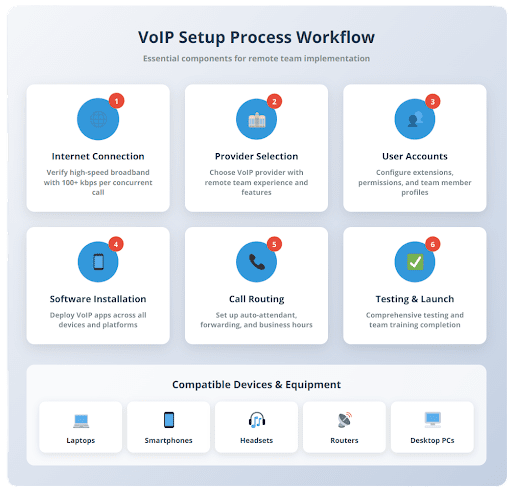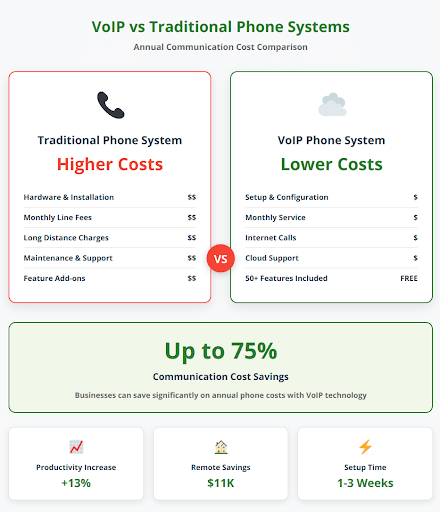VoIP systems transform remote work by cutting communication costs up to 75% while boosting team productivity by 13%.
- Enable seamless calling from any device with an internet connection
- Provide advanced features like call routing, video conferencing, and mobile apps
- Reduce overhead costs while maintaining a professional business presence
- Scale easily as your remote team grows
The key to success lies in proper planning, choosing the right provider, and following a systematic setup process.
Remote work has fundamentally changed how businesses operate, with approximately 35% of US employees now working remotely at least part-time. This shift has made VoIP for remote employees essential for maintaining professional communication standards. Modern business phone systems must support teams working from anywhere while delivering the same reliability and features as traditional office setups.
Setting up VoIP for remote teams requires more than just choosing a provider and hoping for the best. Success depends on understanding your team’s specific needs, preparing the right infrastructure, and implementing a structured approach that ensures everyone stays connected and productive.
Why VoIP for Remote Employees Matters
The transition to remote work has created unprecedented demands on business communication systems. Traditional phone lines simply cannot support the flexibility that modern teams require, while VoIP technology offers solutions specifically designed for distributed workforces.
Remote workers using VoIP systems report 13% higher productivity compared to their office-based counterparts. This improvement stems from VoIP’s ability to integrate multiple communication channels, eliminate technical barriers, and provide consistent access to business tools regardless of location.
The financial benefits are equally compelling. Businesses implementing VoIP for remote employees typically see cost reductions between 50% and 75% on their communication expenses. These savings come from eliminating traditional phone line fees, reducing long-distance charges, and minimizing hardware maintenance costs.
Beyond cost savings, VoIP enables features that traditional phone systems cannot match. Call forwarding ensures important calls never go unanswered, even when team members are working from different time zones. Video conferencing capabilities built into the same platform eliminate the need for separate applications and simplify the user experience.
Pre-Setup Assessment: What You Need Before Starting
Before diving into VoIP implementation, conducting a thorough assessment ensures your remote phone setup will meet both current needs and future growth. This evaluation phase prevents costly mistakes and sets the foundation for successful deployment.
Team Size and Growth Planning Start by identifying exactly how many team members need VoIP access today and project growth over the next 12-18 months. Include both full-time employees and contractors who regularly communicate with clients or team members. Consider whether different users need varying levels of access or features.
Current Communication Patterns Analyze your existing communication habits to understand usage requirements. Track the volume of incoming and outgoing calls, peak usage times, and common call destinations. This data helps determine bandwidth requirements and informs feature selection.
Technical Infrastructure Requirements Every team member needs reliable high-speed internet with minimum upload speeds of 100 kbps per concurrent call. Test internet connections at all work locations to identify potential issues before implementation. Document existing hardware like computers, smartphones, and headsets that could integrate with your VoIP system.
Budget Considerations and Cost Analysis Establish clear budget parameters that include monthly service fees, potential hardware purchases, and implementation costs. Factor in ongoing expenses like training, support, and system maintenance. Compare these costs against your current communication expenses to calculate potential savings.
Security and Compliance Needs Determine whether your business requires specific security certifications or compliance standards. Industries like healthcare need HIPAA-compliant solutions, while financial services may require additional encryption standards. Understanding these requirements upfront prevents compatibility issues later.
Step-by-Step VoIP Setup Process
Successfully implementing VoIP for remote employees requires following a systematic approach that addresses technical, operational, and user experience considerations. This process typically takes 1-3 weeks, depending on team size and complexity.
Step 1: Choose Your VoIP Service Provider Research providers specifically experienced with remote team implementations. Evaluate their track record supporting distributed workforces, available customer support hours, and integration capabilities with other business tools. Request references from similar-sized companies in your industry.
Step 2: Plan Your Number Strategy Decide whether to port existing phone numbers or acquire new ones. Consider getting local numbers in multiple markets where you serve customers, or choose toll-free numbers to project a national presence. Plan extension numbering schemes that make sense for your team structure.
Step 3: Test Internet Connectivity at All Locations Run speed tests from every location where team members will use VoIP services. Verify that upload speeds meet minimum requirements and identify any locations that might need internet upgrades. Test during peak usage times to ensure consistent performance.
Step 4: Configure User Accounts and Extensions Set up individual user accounts with appropriate permissions and features. Assign extension numbers following your planned numbering scheme. Configure voicemail settings, call forwarding rules, and any departmental groupings that match your organizational structure.
Step 5: Install and Configure Software Applications Deploy VoIP applications to all devices that team members will use for business calls. This includes desktop applications, mobile apps, and web-based interfaces. Ensure all applications are configured with the same user credentials and settings.
Step 6: Set Up Call Routing and Business Hours Configure how incoming calls are handled during business hours, after hours, and during holidays. Set up automated attendants, call queues, and routing rules that direct callers to appropriate team members. Test all routing scenarios to ensure they work as expected.
Step 7: Implement Security Measures Enable encryption for all voice traffic and implement user authentication requirements. Configure firewall settings if necessary and establish policies for secure VoIP usage. Train team members on security best practices for remote communication.
Step 8: Conduct Comprehensive Testing Perform test calls between all team members and from external numbers to verify call quality and feature functionality. Test voicemail delivery, call forwarding, conference calling, and any integration features. Document any issues and resolve them before going live.
Step 9: Train Your Team Provide hands-on training for all VoIP features that team members will use regularly. Create quick reference guides for common tasks and establish procedures for requesting technical support. Ensure everyone understands how to access the system from their various work locations.
Step 10: Monitor and Optimize Performance Establish monitoring procedures to track call quality, usage patterns, and system performance. Set up regular check-ins with team members to identify any ongoing issues or feature requests. Plan for periodic system reviews and updates as needs evolve.
Choosing the Right VoIP Provider for Remote Teams
Selecting the ideal VoIP provider for your virtual phone teams requires evaluating specific criteria that impact remote work success. Not all providers offer the same level of support for distributed workforces, making careful evaluation essential.
Remote-Specific Feature Set Look for providers offering robust mobile applications that mirror desktop functionality. The system should support seamless switching between devices without dropping calls or losing features. Evaluate video conferencing capabilities, screen sharing options, and collaboration tools that facilitate remote teamwork.
Reliability and Uptime Guarantees Remote teams depend entirely on their communication systems, making reliability non-negotiable. Seek providers offering uptime guarantees of 99.9% or higher, backed by service level agreements. Research their network infrastructure and redundancy measures that prevent service interruptions.
Customer Support Accessibility Remote teams often work outside traditional business hours, requiring support availability that matches your operational schedule. Evaluate response times for technical issues and the availability of multiple support channels including phone, chat, and email. Consider whether support teams understand remote work challenges.
Integration Capabilities Assess how well the VoIP system integrates with other business tools your team uses regularly. Look for native integrations with customer relationship management systems, project management platforms, and collaboration software. These integrations reduce complexity and improve workflow efficiency.
Scalability and Flexibility Choose providers that make it easy to add or remove users as your remote team grows or changes. Evaluate whether you can adjust feature sets for individual users and modify service levels without significant costs or complexity. Consider international expansion capabilities if your team might grow globally.
Essential Features for Remote Phone Setup
Remote work success depends on having the right VoIP features that support flexible work arrangements while maintaining professional standards. These capabilities distinguish basic phone service from comprehensive communication solutions.
Advanced Call Management Call forwarding becomes crucial when team members work from multiple locations or travel frequently. Look for systems that allow conditional forwarding based on time of day, caller ID, or user availability status. Sequential forwarding can ring multiple numbers until someone answers, ensuring important calls never go to voicemail unnecessarily.
Unified Messaging Systems Voicemail transcription services convert voice messages to text, allowing remote workers to review messages without making phone calls in potentially noisy environments. Email integration delivers voicemails to team members’ inboxes, ensuring messages are never missed even when working offline.
Video Conferencing Integration Built-in video conferencing eliminates the need for separate applications and creates seamless transitions between voice calls and video meetings. Look for features like screen sharing, meeting recording, and the ability to invite external participants without requiring them to install special software.
Mobile Application Functionality Comprehensive mobile apps should provide full access to business phone features from smartphones and tablets. This includes the ability to make calls using business numbers, access voicemail, participate in conference calls, and manage call settings remotely.
Presence and Status Indicators Team visibility features help remote workers coordinate communication effectively. Status indicators show when colleagues are available, busy, or away, reducing unnecessary interruptions and improving response times for urgent matters.
Call Analytics and Reporting Detailed call reports help managers understand communication patterns and identify potential issues before they impact productivity. Look for systems that track call quality metrics, usage statistics, and performance indicators that inform optimization decisions.
Setting Up Virtual Phone Teams: Best Practices
Creating effective virtual phone teams requires more than just technical implementation. Success depends on establishing clear procedures, communication standards, and support systems that enable remote workers to communicate professionally and efficiently.
Establish Clear Communication Protocols Develop guidelines that specify when to use different communication methods and expected response times for various types of calls. Create escalation procedures for urgent situations and define protocols for handling client communications across different time zones.
Implement Consistent User Training Provide comprehensive training that covers not just basic phone functionality but also advanced features that improve remote work efficiency. Create standardized training materials that new team members can access independently, and establish regular refresher sessions to introduce new features.
Design Effective Call Routing Strategies Structure call routing to match your team’s availability patterns and expertise areas. Use time-based routing to handle calls differently during business hours, lunch periods, and after-hours. Implement skill-based routing that directs specialized inquiries to team members with relevant expertise.
Create Backup and Redundancy Plans Develop procedures for handling communication during internet outages or technical problems. This might include call forwarding to mobile phones, temporary use of alternative internet connections, or predetermined backup communication methods for critical situations.
Monitor Call Quality and Performance Establish regular monitoring procedures that track call quality metrics and identify potential issues before they impact customer experience. Create feedback mechanisms that allow team members to report technical problems or suggest system improvements.
Maintain Professional Standards Develop guidelines for home office setup that ensure professional call quality and minimize background noise. Provide recommendations for headsets, internet connections, and workspace configurations that support high-quality business communications.
Troubleshooting Common Remote VoIP Issues
Even well-planned VoIP implementations occasionally encounter technical challenges that can disrupt remote team productivity. Understanding common issues and their solutions helps maintain consistent communication quality and minimizes downtime.
Audio Quality Problems Poor call quality often stems from insufficient internet bandwidth or network congestion. When team members experience choppy audio or dropped calls, first verify that their internet connection meets minimum speed requirements. Recommend wired ethernet connections over Wi-Fi when possible, as they provide more stable performance for voice traffic.
Network interference from other devices can also impact call quality. Advise team members to minimize bandwidth-intensive activities like video streaming or large file downloads during important calls. Quality of Service settings on routers can prioritize voice traffic over other internet usage.
Connection and Login Issues Authentication problems typically occur when team members change internet connections or work from new locations. Ensure everyone understands how to update their device settings when switching networks. Provide clear instructions for logging out and back into VoIP applications when experiencing connection problems.
Firewall configurations sometimes block VoIP traffic, particularly on corporate or public networks. Document the specific ports and protocols your VoIP system uses, and provide instructions for requesting network access when team members encounter blocking issues.
Device Compatibility Challenges Different devices and operating systems occasionally experience compatibility issues with VoIP applications. Maintain an updated list of supported devices and operating system versions. Provide alternative access methods, such as web-based applications, for team members using unsupported devices.
Echo and Feedback Problems Audio feedback typically results from using speakers instead of headsets during calls. Recommend quality headsets for all team members who regularly participate in phone calls. When echo problems persist, check for multiple audio devices being active simultaneously on the same computer.
Emergency Service Limitations Remote workers must understand that VoIP emergency calling may not automatically provide their current location to emergency services. Ensure all team members update their emergency addresses when working from different locations, and maintain procedures for contacting local emergency services directly when necessary.
How Much Does VoIP for Remote Employees Cost?
Understanding the true cost of implementing VoIP for remote employees helps businesses budget accurately and calculate return on investment. Pricing varies significantly based on features, user count, and service levels, but most businesses realize substantial savings compared to traditional phone systems.
Monthly Service Costs Basic VoIP plans for small businesses typically start around $15-25 per user per month, while advanced plans with comprehensive features range from $35-50 per user monthly. Research indicates that businesses implementing remote work policies save an average of $11,000 annually per remote employee, largely offsetting communication technology costs.
Implementation and Setup Expenses Initial setup costs include number porting fees, which range from free to $25 per number depending on the provider. User training and system configuration typically require 2-4 hours per team member, representing an investment in long-term productivity and adoption success.
Hardware and Equipment Costs Remote teams often require minimal additional hardware beyond quality headsets, which cost $50-200 per user. Many team members can use existing computers and smartphones with VoIP applications, eliminating the need for dedicated desk phones. Businesses may need to upgrade internet connections at some remote locations, with costs varying by location and service provider.
Ongoing Operational Expenses Monthly costs remain relatively predictable with cloud-based VoIP services, as providers handle system maintenance and updates. Some businesses opt to reimburse team members for increased internet costs or home office equipment, typically adding $50-100 per month per remote worker.
Cost Comparison and ROI Calculation Businesses switching to VoIP typically save 50-75% on communication costs compared to traditional phone systems. These savings come from eliminating line rental fees, reducing long-distance charges, and minimizing maintenance costs for physical hardware.
The return on investment extends beyond direct cost savings. Remote workers report higher job satisfaction and productivity levels, leading to reduced turnover costs and improved business outcomes. When factoring in these indirect benefits, most businesses recover their VoIP implementation costs within 3-6 months.
Security Considerations for Remote VoIP Systems
Implementing VoIP for distributed teams introduces security considerations that require proactive planning and ongoing attention. Remote work environments present unique challenges that traditional office-based phone systems never faced.
Network Security Fundamentals Every remote worker’s internet connection becomes a potential entry point into your business communication system. Implement strong encryption for all voice traffic and require secure authentication for system access. Use Virtual Private Network connections when possible to create secure tunnels for VoIP traffic.
Device Management and Control Establish policies governing which devices can access your VoIP system and how they must be configured. Require regular software updates and security patches on all devices used for business communications. Consider implementing mobile device management solutions for company-provided smartphones and tablets.
Access Control and User Authentication Implement multi-factor authentication for all VoIP system access, particularly for administrative functions and sensitive features. Regularly review user permissions and remove access for departed team members promptly. Use strong password requirements and consider single sign-on integration with other business systems.
Monitoring and Incident Response Establish monitoring procedures that can detect unusual calling patterns or potential security breaches. Create incident response procedures specifically for communication system security events. Regular security audits help identify vulnerabilities before they can be exploited.
According to recent cybersecurity research, 78% of businesses consider cybersecurity critical for safe remote work, yet 35% feel they lack adequate security measures. This gap underscores the importance of prioritizing security during VoIP implementation.
Integration with Business Tools and Workflow
Successful VoIP implementation for remote teams extends beyond basic calling functionality to encompass integration with existing business processes and tools. These connections create seamless workflows that improve efficiency and reduce complexity for distributed teams.
Customer Relationship Management Integration Connecting your VoIP system with CRM platforms enables automatic call logging, contact information lookup, and streamlined customer interaction tracking. Remote team members can access customer history before answering calls, improving service quality and reducing call handling time.
Project Management and Collaboration Platforms Integration with project management tools allows team members to initiate calls directly from task discussions or project updates. This connection maintains context around business conversations and ensures important decisions are properly documented within existing workflow systems.
Calendar and Scheduling Integration Synchronizing VoIP systems with calendar applications enables features like automatic call forwarding based on meeting schedules and one-click conference call setup for scheduled meetings. Remote workers can manage their availability status automatically based on calendar events.
Document and File Sharing Systems Advanced VoIP platforms offer screen sharing and document collaboration features that integrate with existing file storage systems. This capability enables remote teams to review documents together during calls without switching between multiple applications.
Reporting and Analytics Integration Connecting VoIP data with business intelligence platforms provides insights into communication patterns, customer service metrics, and team productivity indicators. This information helps managers optimize remote work processes and identify areas for improvement.
Transform Your Remote Team Communication Today
The transformation from traditional communication methods to professional VoIP systems opens new possibilities for remote team success. Implementing the right solution requires careful planning, but the benefits of improved communication, reduced costs, and enhanced flexibility make the investment worthwhile for businesses of all sizes.
Effective business communication directly impacts productivity, with studies showing that companies with strong communication practices enjoy 47% higher returns to shareholders compared to those with poor communication systems. Research indicates that miscommunication in the workplace costs US businesses an estimated $1.2 trillion annually, making reliable communication systems essential for business success.
The key to successful implementation lies in taking a systematic approach that addresses technical requirements, user training, and ongoing optimization. Teams that follow structured setup processes and choose providers experienced with remote work environments consistently achieve better outcomes and faster user adoption.
Transform Your Remote Team Communication Today
Remote work continues reshaping how businesses operate, with communication technology serving as the foundation for distributed team success. VoIP systems designed specifically for remote employees provide the reliability, features, and cost-effectiveness that modern businesses require to thrive in an increasingly flexible work environment.
The businesses that implement comprehensive VoIP solutions position themselves to attract top talent regardless of geographic location, reduce operational costs significantly, and maintain professional communication standards that support long-term growth. Whether your team is fully remote, hybrid, or planning for future flexibility, the right VoIP system creates possibilities that traditional phone systems simply cannot match.
Ready to transform your remote team’s communication capabilities? Explore how professional VoIP solutions can streamline your operations and boost productivity. Get started with a comprehensive business phone system that’s designed specifically for the modern, mobile workforce.
Frequently Asked Questions
How long does it take to set up VoIP for a remote team? Implementation typically takes 1-3 weeks depending on team size and complexity. Simple setups with existing internet infrastructure can be completed in just a few days, while larger teams requiring custom configurations may need 2-4 weeks for full deployment.
Can remote workers use VoIP on their personal devices? Yes, most VoIP systems offer mobile applications that work on personal smartphones and tablets. However, businesses should establish clear policies regarding personal device usage and may prefer to provide company devices for security and compliance reasons.
What internet speed do remote workers need for VoIP calls? Each concurrent VoIP call requires approximately 100 kbps of bandwidth for both upload and download. Most modern broadband connections easily support multiple simultaneous calls, but team members should test their connections during peak usage times to ensure adequate performance.
How does VoIP handle emergency calls for remote workers? VoIP emergency calling may not automatically provide the caller’s current location to emergency services. Remote workers must keep their emergency addresses updated in the system and understand how to contact local emergency services directly when working from different locations.
What happens if a remote worker’s internet goes down? Most VoIP systems offer call forwarding to mobile phones as a backup option. Advanced systems can automatically detect connection failures and redirect calls to predetermined backup numbers, ensuring business continuity during technical problems.






